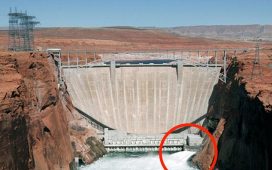On May 18, 1980, Mount St Helens erupted in the US state of Washington. The event, which measured 5 on the Volcanic Explosively Index, has been declared the most disastrous in modern US history. A huge column of volcanic material rose 80,000ft into the atmosphere and deposited ash in 11 states, killing at least 57 people and causing more than £770million in damage.
The volcano, which is still an active stratovolcano, had not posed a threat since its last period of activity in the Forties and Fifties.
As a result, when the United States Geological Survey (USGS) scientists warned of the potential dangers in March 1980, many local residents refused to leave.
However, the chilling moment the gravity of the situation hit home was revealed during Amazon Prime’s “The Fire Below Us” documentary.
The 1995 series showed viewers the first news report that local residents would have seen after the volcano “shook itself awake” in April 1980.
The reporter says: “We are directly over Mount St Helens right now.
“We are at the 10,000 feet level and there is no question at all that the volcanic activity has begun.
“You can see smoke and ash pouring from the top of the mountain, especially on the north side.”
A few days later, a second larger crater emerged.
Then, a “dreadful discovery” showed a 200-foot high bulge had emerged on the north side and was growing at over five feet a day.
David Johnston, a volcanologist who was part of the team monitoring Mount St Helens sent a warning to the public after the discovery.
He said: “I would say this is an impressive sign that something is going on, it is heating up.
“But right now there’s a great hazard due to the fact the glacier is breaking up on this side of the volcano – the north side.
“That could produce a very large avalanche hazard.
“This is not a good spot to be standing in.”
Days later, on May 18, 1980, the volcano erupted, killing Dr Johnston in the process along with dozens more.
At 8:32am, a magnitude 5.1 earthquake centred directly below the north slope triggered that part of the volcano to slide approximately seven seconds after the shock.
The landslide, the largest in recorded history, travelled at 110 to 155 mph and moved across Spirit Lake’s west arm.
The landslide exposed the dacite magma in St. Helens’ neck to much lower pressure, causing the gas-charged, partially molten rock and high-pressure steam above it to erupt a few seconds after the landslide started.
The resulting blast laterally directed the pyroclastic flow of very hot volcanic gases, ash and pumice formed from new lava, while the pulverised old rock hugged the ground – initially moving at 220mph but quickly accelerating to 670mph.
Pyroclastic flow material passed over the moving avalanche and spread outwards, devastating a total of about 240 square miles of forest.
The huge ensuing ash cloud sent skyward from St. Helens’ northern foot was visible throughout surrounding areas.
The near-supersonic lateral blast, loaded with volcanic debris, caused devastation as far as 19 miles from the volcano.














